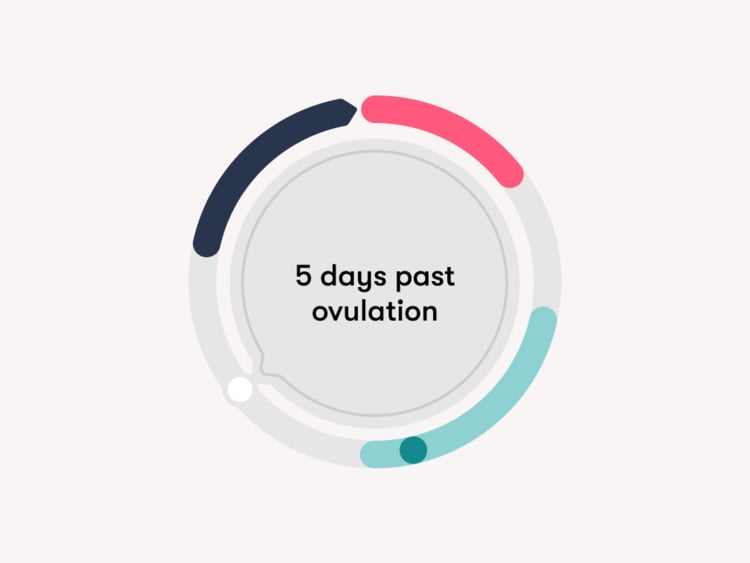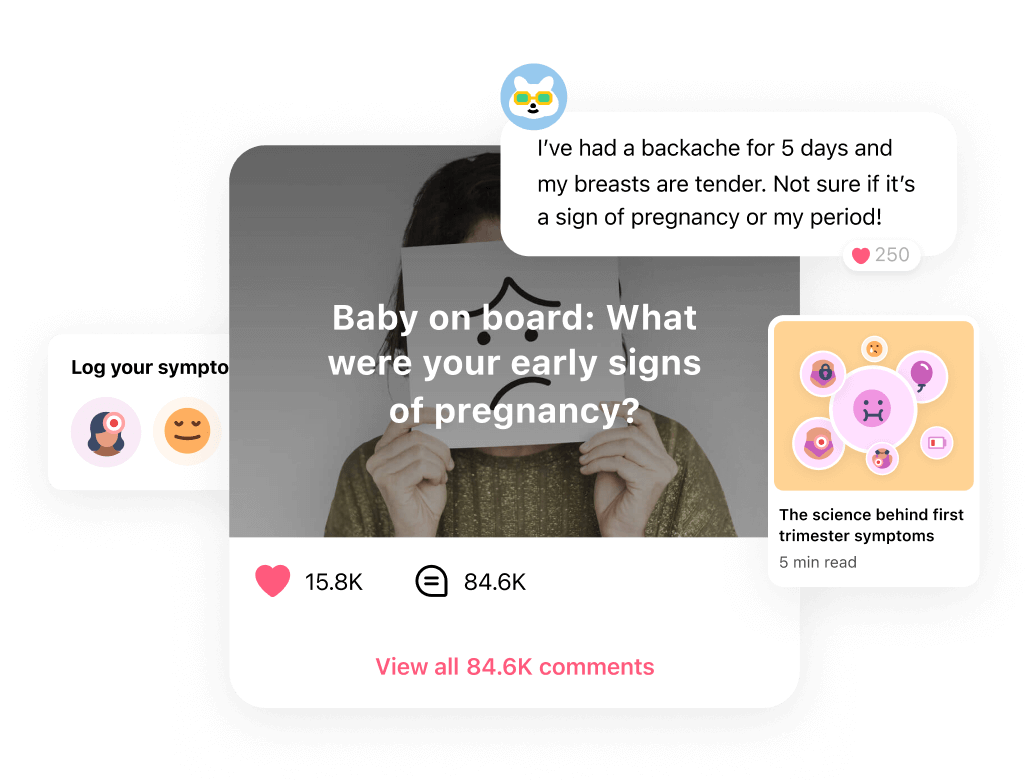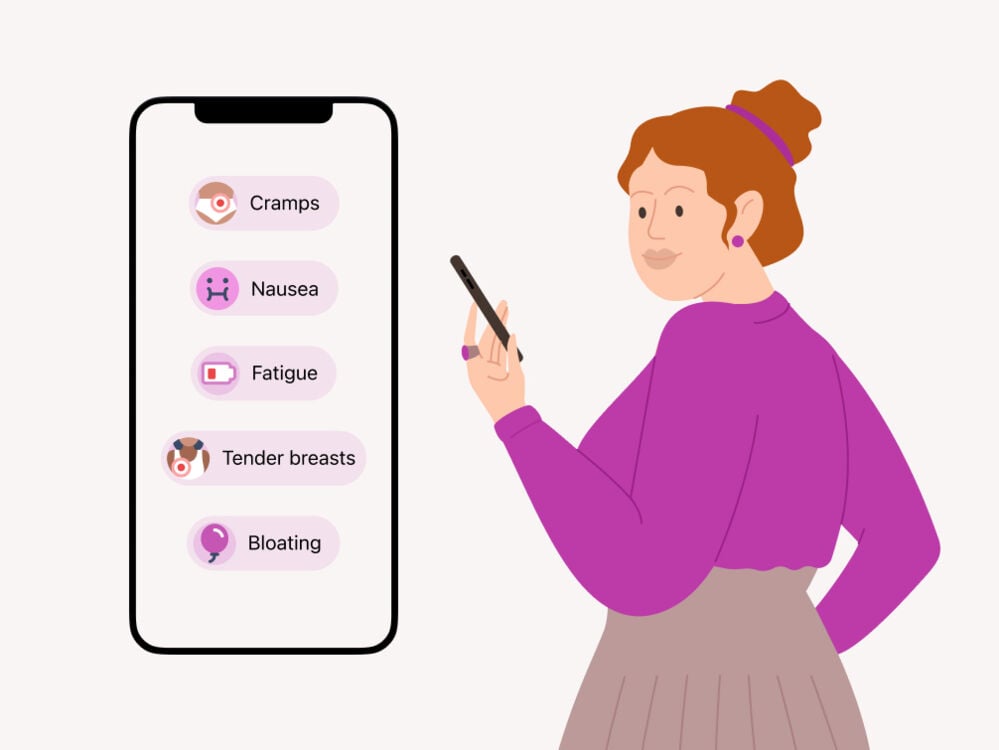Are you wondering when you can take a pregnancy test? Here’s the lowdown on 5 DPO.
-
Tracking cycle
-
Getting pregnant
-
Pregnancy
-
Help Center
-
Flo for Partners
-
Anonymous Mode
-
Flo app reviews
-
Flo Premium New
-
Secret Chats New
-
Symptom Checker New
-
Your cycle
-
Health 360°
-
Getting pregnant
-
Pregnancy
-
Being a mom
-
LGBTQ+
-
Quizzes
-
Ovulation calculator
-
hCG calculator
-
Pregnancy test calculator
-
Menstrual cycle calculator
-
Period calculator
-
Implantation calculator
-
Pregnancy weeks to months calculator
-
Pregnancy due date calculator
-
IVF and FET due date calculator
-
Due date calculator by ultrasound
-
Medical Affairs
-
Science & Research
-
Pass It On Project New
-
Privacy Portal
-
Press Center
-
Flo Accuracy
-
Careers
-
Contact Us
5 DPO: Are there any pregnancy symptoms at 5 days past ovulation?


Every piece of content at Flo Health adheres to the highest editorial standards for language, style, and medical accuracy. To learn what we do to deliver the best health and lifestyle insights to you, check out our content review principles.
Do you think you might be pregnant but aren’t totally sure? Whether you’re trying for a baby or not, not knowing can leave you feeling like you’re in limbo. It’s recommended that you wait until the first day of a missed period before taking a pregnancy test in order to get an accurate result. However, the two weeks between ovulation and when your period is due (the two-week wait) can feel like an eternity.
So, do you really have to wait for a missed period, or can you tell if you’re pregnant as early as five days past ovulation (DPO)?
Key takeaways
- 5 DPO is generally too early for pregnancy symptoms to be detected because implantation (when the embryo attaches to your uterine lining) hasn’t happened yet. This doesn’t necessarily mean you won’t get pregnant though.
- Confusingly, your monthly menstrual cycle and early pregnancy can share some pretty similar symptoms, and it can be hard to know if you’re pregnant based on your symptoms alone.
- Pregnancy symptoms don’t usually start until after implantation, as early as six DPO.
- The best time to take a pregnancy test is starting from the first day of your missed period, when your levels of the pregnancy hormone human chorionic gonadotropin (hCG) should be high enough to be detected in your urine.

 Over
7.8M
ratings averaging
4.8/5
*
Over
7.8M
ratings averaging
4.8/5
*
Understand your body’s signals with the Flo app
- Chat with others who are trying to get pregnant.
- Get trusted information on signs of pregnancy from 100+ medical experts.
- Log your symptoms and learn what they could be trying to tell you.
 Over
7.8M
ratings averaging
4.8/5
*
Over
7.8M
ratings averaging
4.8/5
*

Trying to conceive?
The Flo app can help you through the two-week wait.

 Over
7.8M
ratings averaging
4.8/5
*
Over
7.8M
ratings averaging
4.8/5
*
Understand your body’s signals with the Flo app
- Chat with others who are trying to get pregnant.
- Get trusted information on signs of pregnancy from 100+ medical experts.
- Log your symptoms and learn what they could be trying to tell you.
5 DPO: What to expect
5 DPO simply means five days past ovulation — and DPO is one of the many fertility acronyms people use (we’ve rounded up the most common ones here).
You might be curious about what “days past ovulation” actually means and why it’s important. Breaking your cycle down into two sections can help.
- The follicular phase: The first part of your cycle is known as your follicular phase. It starts on the first day of a new cycle, which lines up with the first day of a new period. The length of your period is pretty personal to you. Your follicular phase can cover around the first two weeks of your cycle (depending on how long your cycle is). At this point, your estrogen levels rise to prepare your body for ovulation. This triggers the lining of your uterus to thicken and — if fertilization happens — this is where your egg will implant.
- The luteal phase: Between days 14 and the end of your cycle, you enter the luteal phase. It starts after ovulation, which is when one of your ovaries releases an egg. Following this, your progesterone levels rise, and if your egg was fertilized by a sperm, then it may implant into the lining of your uterus, and you may become pregnant.
Wondering where 5 DPO sits in your cycle? You’re in the luteal phase at this point, so if you had sex over the last few days, then you may have conceived. However, you aren’t technically considered to be pregnant just yet. This is because your fertilized egg needs to travel down your uterine tubes and implant into the inner lining of your uterus. This usually happens six to 10 days after ovulation, so you won’t be considered pregnant until six to 10 DPO. This doesn’t mean you won’t become pregnant this cycle; your body just needs a little more time.
After implantation, your body starts to release a hormone called human chorionic gonadotropin (hCG), which is what at-home pregnancy tests detect in your urine. Early pregnancy symptoms might start at this point, but it can take a little bit longer for them to begin in other people. So you might not feel much different, and that’s very normal, too.
Can I take a pregnancy test at 5 DPO, or is it too early?
If you’re trying for a baby, then you might be on the lookout for the telltale signs of early pregnancy and wonder if you can take a pregnancy test at 5 DPO. However, as implantation probably hasn’t happened just yet, it’s too early to take a test at this point. It’s best to wait until the first day of a missed period. This might feel like a long time to wait, but it’s really important that you give your body enough time to produce enough hCG to be picked up by a test.
This wait of around two weeks — commonly called “the two-week wait” — can be difficult, so try to be gentle with yourself. It’s understandable if pregnancy is on your mind, but distracting yourself with small things that bring you joy can make a difference. That might be reaching out to friends, going for a coffee, or doing the small things that you know make you feel peaceful.
5 DPO symptoms
While it might still be a little too early to take a pregnancy test, you might feel slightly different at 5 DPO and be curious why. It can be tough to differentiate between premenstrual symptoms and implantation, as they often happen at around the same time in your menstrual cycle. So, many early pregnancy symptoms including cramping, nausea, and fatigue could also be a sign of premenstrual syndrome (PMS). Confusing, right?
The earliest 5 DPO symptoms you may start to notice include:
Cramping
You may be no stranger to cramps around the time of your period, as they’re a common PMS symptom that some people experience. However, abdominal cramping is also fairly typical around the time of implantation.
Cramping can be linked to hormone-like substances called prostaglandins. They’re produced by the lining of your uterus and can cause it to contract. This is why you might feel cramping or discomfort just before your period. However, cramping during implantation could be a sign that your fertilized egg has attached to your uterine wall.
Nausea
You might also feel queasy around the time of your period, as period nausea is also common during your luteal phase. Nausea is also listed as one of the early signs of pregnancy that you might spot in your 1st trimester. We’ve all heard tales of so-called “morning or pregnancy sickness.” Here’s the thing: As your hCG levels rise, it might leave you running for the toilet.

Breast pain
Sore boobs aren’t unusual in early pregnancy, but — you guessed it — they can also signal the start of your period. This is because the way your boobs look and feel can change depending on your hormones. When you’re pregnant, your body starts to produce the hormone prolactin in preparation for milk production. Your boobs might feel sore when this happens. Similarly, you might notice that your boobs feel more tender at different points in your menstrual cycle. This is known as cyclical breast pain and is caused by a rise in your progesterone levels just before your period starts.
Frequent urination
You might associate needing to pee more than usual with a growing baby bump, but it’s actually fairly common at every stage of pregnancy. In early pregnancy, you may need to pee more as your blood volume increases. This means that your kidneys have to work extra hard to filter out any impurities, and they leave your body through your urine.
However, needing to pee more than normal can also be a sign that you’re drinking too much fluid, you’re drinking more caffeine or alcohol, or — if it’s accompanied by symptoms like burning and a funny smell — you might have a urinary tract infection, which is easily treated. Be sure to book a checkup with your doctor if that sounds like you.
Fatigue
As your progesterone levels rise during your luteal phase, you might find that you’re reaching for the blanket a little earlier in the evening than normal. This is because, while progesterone plays a key role in thickening the lining of your uterus before implantation, it can also leave you feeling sleepier.
Headaches
Have you ever heard of hormone headaches? While having a sore head can be a real pain, it’s actually quite common. As your estrogen and progesterone levels drop, you may be more likely to experience headaches.
As your hormone levels fluctuate and your blood volume increases, you might also experience more headaches than normal during early pregnancy. This can be a pretty frustrating symptom, so don’t hesitate to speak to your doctor.
Take a quiz
Find out what you can do with our Health Assistant
5 DPO and no symptoms
It’s pretty clear that early pregnancy symptoms and the changes in the way you might feel around ovulation and your period can be pretty similar. As implantation probably hasn't happened just yet, it’s still very early to feel any different. If you haven’t noticed any pregnancy symptoms at this point, then try not to worry. That’s very normal.
More FAQs
How do you feel 5 days after ovulation?
It’d be lovely to have a checklist of surefire changes you’ll feel at 5 DPO, but the truth is, implantation probably hasn’t happened just yet. This doesn’t mean it won’t this cycle; it’s totally normal not to feel any symptoms at 5 DPO.
How do you know if implantation failed?
Implantation failure is the term used when your fertilized egg doesn’t implant into the lining of your uterus. Failure is a severe term, and if you’re trying for a baby, this can be really disappointing. It’s crucial to remember that you didn’t fail in this.
Generally speaking, if you aren’t undergoing fertility treatment, then there’s no real way of knowing if implantation has “failed.” You may not have become pregnant in one cycle because an egg wasn’t fertilized after ovulation, or a fertilized egg didn’t attach to your uterine wall.
If you are currently undergoing in vitro fertilization, then your doctor may check if implantation has happened after your embryo transfer. This means you might be more aware if it hasn’t happened. However, if your fertilized egg doesn’t implant during one cycle, it doesn’t mean it won’t in another.
What triggers hCG to rise?
During the first trimester of pregnancy, your hCG levels rise rapidly every 48 to 72 hours until you’re around 10 weeks pregnant. This is the hormone that’s produced by your placenta. Did you know that when you become pregnant, you don’t just grow a baby? You grow a new organ too. Your placenta grows in your uterus after implantation and provides nutrients and oxygen to your baby. It releases hCG during your 1st trimester. As your hCG levels rise over time, they become easier to detect on a pregnancy test. This is why it’s better to wait until the first day of your missed period before taking a test.


Hey, I'm Anique
I started using Flo app to track my period and ovulation because we wanted to have a baby.


The Flo app helped me learn about my body and spot ovulation signs during our conception journey.


I vividly
remember the day
that we switched
Flo into
Pregnancy Mode — it was
such a special
moment.
Real stories, real results
Learn how the Flo app became an amazing cheerleader for us on our conception journey.
References
“Am I Pregnant?” Cleveland Clinic, my.clevelandclinic.org/health/articles/9709-pregnancy-am-i-pregnant. Accessed 16 Nov. 2023.
Betz, Danielle, and Kathleen Fane. “Human Chorionic Gonadotropin.” StatPearls, StatPearls Publishing, 2023, www.ncbi.nlm.nih.gov/books/NBK532950/.
“Changes during Pregnancy.” The American College of Obstetricians and Gynecologists, www.acog.org/womens-health/infographics/changes-during-pregnancy. Accessed 16 Nov. 2023.
“Common Health Problems in Pregnancy.” NHS, www.nhs.uk/pregnancy/related-conditions/common-symptoms/common-health-problems/. Accessed 17 Nov. 2023.
“Doing a Pregnancy Test.” NHS, www.nhs.uk/pregnancy/trying-for-a-baby/doing-a-pregnancy-test/. Accessed 17 Nov. 2023
“Frequent Urination.” Mayo Clinic, 19 May 2023, www.mayoclinic.org/symptoms/frequent-urination/basics/causes/sym-20050712.
Gudipally, Pratyusha R., and Gyanendra K. Sharma. “Premenstrual Syndrome.” StatPearls. StatPearls Publishing, 2023, www.ncbi.nlm.nih.gov/books/NBK560698/.
“Headaches in Early Pregnancy.” Stanford Medicine Children’s Health, www.stanfordchildrens.org/en/topic/default?id=headaches-in-early-pregnancy-134-3. Accessed 16 Nov. 2023.
“Implantation Bleeding.” Cleveland Clinic, my.clevelandclinic.org/health/symptoms/24536-implantation-bleeding. Accessed 16 Nov. 2023.
“In Vitro Fertilization (IVF).” Mayo Clinic, 1 Sep. 2023, www.mayoclinic.org/tests-procedures/in-vitro-fertilization/about/pac-20384716.
“Luteal Phase.” Cleveland Clinic, my.clevelandclinic.org/health/articles/24417-luteal-phase. Accessed 16 Nov. 2023.
“Menstrual Cramps.” Mayo Clinic, 30 Apr. 2022, www.mayoclinic.org/diseases-conditions/menstrual-cramps/symptoms-causes/syc-20374938.
“Menstrual Cycle.” Manuals, M. S. D, 2023, www.msdmanuals.com/en-gb/home/women-s-health-issues/biology-of-the-female-reproductive-system/menstrual-cycle.
“Menstrual Migraines: Treatment, Pain Relief & Symptoms.” Cleveland Clinic, my.clevelandclinic.org/health/diseases/8260-menstrual-migraines-hormone-headaches. Accessed 16 Nov. 2023.
“Is Nausea during Pregnancy a Good Sign?” Mayo Clinic, 26 Oct. 2021, www.mayoclinic.org/healthy-lifestyle/pregnancy-week-by-week/expert-answers/nausea-during-pregnancy/faq-20057917.
“Ovulation.” Cleveland Clinic, my.clevelandclinic.org/health/articles/23439-ovulation. Accessed 16 Nov. 2023.
“Premenstrual Syndrome (PMS).” Mayo Clinic, 25 Feb. 2022, www.mayoclinic.org/diseases-conditions/premenstrual-syndrome/symptoms-causes/syc-20376780.
“Prolactin.” Cleveland Clinic, my.clevelandclinic.org/health/articles/22429-prolactin. Accessed 16 Nov. 2023.
“Signs and Symptoms of Pregnancy.” NHS, www.nhs.uk/pregnancy/trying-for-a-baby/signs-and-symptoms-of-pregnancy/. Accessed 17 Nov. 2023.
Su, Ren-Wei, and Asgerally T. Fazleabas. “Implantation and Establishment of Pregnancy in Human and Nonhuman Primates.” Advances in Anatomy, Embryology, and Cell Biology, vol. 216, 2015, pp. 189–213, https://doi.org/10.1007%2F978-3-319-15856-3_10.
“Stomach Pain in Pregnancy.” NHS, www.nhs.uk/pregnancy/related-conditions/common-symptoms/stomach-pain/. Accessed 17 Nov. 2023.
“Symptoms of Pregnancy: What Happens First.” Mayo Clinic, 3 Dec. 2021, www.mayoclinic.org/healthy-lifestyle/getting-pregnant/in-depth/symptoms-of-pregnancy/art-20043853.
“Tiredness and Sleep Problems.” NHS, www.nhs.uk/pregnancy/related-conditions/common-symptoms/tiredness/. Accessed 17 Nov. 2023.
Thiyagarajan, Dhanalakshmi K., et al. “Physiology, Menstrual Cycle.” StatPearls. StatPearls Publishing, 2022, www.ncbi.nlm.nih.gov/books/NBK500020/.
“Week 4.” Start for Life, www.nhs.uk/start-for-life/pregnancy/week-by-week-guide-to-pregnancy/1st-trimester/week-4/. Accessed 16 Nov. 2023.
“You and Your Pregnancy at 1 to 3 Weeks.” NHS, www.nhs.uk/pregnancy/week-by-week/1-to-12/1-2-3-weeks/. Accessed 17 Nov. 2023.
History of updates
Current version (24 November 2023)
Published (10 May 2019)
In this article

Get your personal guide to fertility
-
Learn how to read your body's ovulation signals
-
Find daily conception tips from our experts
-
Chat with others who are trying to get pregnant




